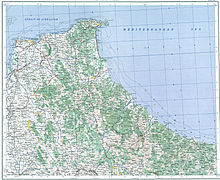Ksar es-Seghir
Ksar es-Seghir
القصر الصغير | |
|---|---|
UTC+1 (WEST ) |

Ksar es-Seghir (
The city is circular, a design unusual in medieval Moroccan town planning. It is built from brick and ashlar masonry and flanked by semi-circular masonry towers. There are three monumental doors in the wall, each flanked by square towers. The Bāb al-Bahr (door of the sea), has an elbowed entrance for defensive purposes. These doors were used both for communication and trade and for taxation purposes.[2]
Names
The
In
Geography

Ksar es-Seghir is located in the Strait of Gibraltar about halfway between Tangier and Ceuta. Situated in a bay on a stretch of coast that is relatively difficult to access by sea or land, Ksar es-Seghir never grew in size to rival the other north Moroccan ports. However, its sheltered position made it attractive as a military landing ground, a place for the safe and orderly embarkation and disembarkation of sea-borne troops, with little danger of disruption or molestation by enemy action.[2]
History
Exilissa was probably established as a
In 1287,
In 1458, a
Finding Portuguese holdings in Morocco expensive to maintain, King John III of Portugal decided to abandon it in 1533,[2] although the final evacuation of Ksar es-Seghir would be delayed until 1549. It was recovered by Morocco thereafter, but the departing Portuguese had taken the trouble to evacuate the population, dismantle much of the fortifications and town, and dump debris and sand into the harbor, diminishing its immediate usefulness. In 1609, Ksar es-Seghir became a destination for Moriscos expelled from Spain.[6]
Having lost its role as a transit port, Ksar es-Seghir collapsed in size and importance thereafter, becoming a relatively insignificant fishing town, amid the ruins of the old Moroccan citadel and Portuguese fort. A more modern town arose later, on the right bank of the river, across from the old citadel. Ksar Sghir got a new lease on life in the 21st century, when it was slated as the site of a new
See also
References
Citations
- ^ Haut Commissariat au plan, Census 2004 Archived 1 June 2010 at the Wayback Machine
- ^ a b c d e "Qantara Mediterranean Heritage". Archived from the original on 8 October 2011. Retrieved 17 January 2011.
- Nat. Hist., Book V, §2.
- Geogr., Book IV, Ch. i, §3.
- ^ a b Lipiński (2004), p. 422–425.
- ^ a b c "Tangier, Ksar es Seghir, Terremaroc.com : Riad Marrakesh | Villa Marrakesh | Riad Essaouira | Guest House Morocco". www.terremaroc.com. Retrieved 16 February 2018.
- ^ "Le Maroc se dote de sa première base navale - Afrik.com : l'actualité de l'Afrique noire et du Maghreb". www.afrik.com. Retrieved 16 February 2018.
- ^ Pike, John. "Royal Moroccan Navy". www.globalsecurity.org. Retrieved 16 February 2018.
Bibliography
- Braga, Paulo Drumond. A Expansão no Norte de África. In: Nova História da Expansão Portuguesa (dir. de Joel Serrão e A. H. de Oliveira Marques). Lisboa: Editorial Estampa, 1998. Vol. II, A Expansão Quatrocentista. pp. 237–360.
- Duarte, Luís Miguel. África. In: Nova História Militar de Portugal (dir. de Themudo Barata e Nuno Severiano Teixeira). Lisboa: Circulo de Leitores, 2003. vol. I, pp. 392–441.
- Elbl, Martin Malcolm. "The Master-Builder, the Bureaucrat, and the Practical Soldier: Protecting Alcácer Seguer/Qasr al-Saghir (Morocco) in the Early Sixteenth Century," Portuguese Studies Review 12 (1) (2004/5), pp. 33–73. [1]
- ISBN 9789042913448.
- Redman, Charles L. Qsar es-Seghir: an archaeological view of medieval life. London, Academic Press, 1986.

